#87 Peruvian sojourn
Inge Bolin
Thirst in the Andes: Climate Change and Solutions for Survival
First published Feb. 14, 2017
*
Inge Bolin’s first novel, When Condors Call (Nanaimo: Chaska Publications, 2010) follows a young physician from the Peruvian Andes in search of a cure for Leishmaniasis, a disfiguring disease.
Her 2016 stay in Peru enabled her to discover that, due to climate change, the disfiguring and deadly disease Leishmaniasis, which is at the center of her novel, is on the increase and has reached epidemic proportions in some regions.
While calling attention to the Zika virus, Doctors without Borders has also cited Leishmaniasis as one of the most dangerous and neglected tropical diseases.
The royalties for Bolin’s self-published novel go to an NGO of volunteers called “Yachaq Runa” which she founded in Cuzco, Peru, in 1992, for connecting Andean Medicine, Nutrition and Ecology.
Almost ever year since 1988, Inge Bolin, who speaks six languages, has revisited the people of the high Peruvian Andes.
Bolin recently returned to some of the highest inhabitable regions of the Andes to do research for a forthcoming new book to be called Thirst in the Andes – Climate Change and Solutions for Survival. Here she provides an overview of work and her ongoing involvement with the indigenous people of the Andes who are suffering from Leishmaniasis in both the highlands and the lowlands of Peru.
*
WHY I WRITE ABOUT THE PERUVIAN ANDES
Those who have written a book know that to get the job done an author must spend much time alone, mostly indoors, often foregoing interesting events and seldom knowing beforehand whether one’s message will ever get to the public.
As someone who loves the outdoors and a social lifestyle, writing books was not on my agenda at the beginning of my anthropological career, apart from the M.A. and Ph.D. theses, which are required and an occasional article or chapter for an edited volume. “Publish or Perish” is integral to many universities, but was not enforced at Malaspina College, now Vancouver Island University, where I began to teach in 1989.
However, as I became more deeply involved in research and applied work with indigenous Peruvian societies, I realized that the complexity and inherent value of their ideology and lifeways, deserved more than short descriptions or brief analyses. It soon became evident that we could learn much from people who have been able to make a living under very challenging circumstances within a marginal environment. On the other hand, the negative stereotype which had often been assigned to closed Andean communities by outsiders who had little, if any, actual experience among indigenous people, deserved reconsideration.
In 1988 I felt very fortunate when the healer of Chillihuani, a village located within the towering Andean mountains between 4000 and 5000 m.a.s.l., came to the valley where my compadre Antolin introduced us. I could hardly believe my ears when the healer invited me to celebrate with him and his family the ancient fiesta of Pukllay.

Few people in the valley had ever climbed to this village of llama and alpaca herders. They warned me about the precipitous mountains, unpredictable weather, lack of roads, simple living conditions in earthen huts without light and running water and the fact that most people only knew Quechua, the language of their Inca ancestors.
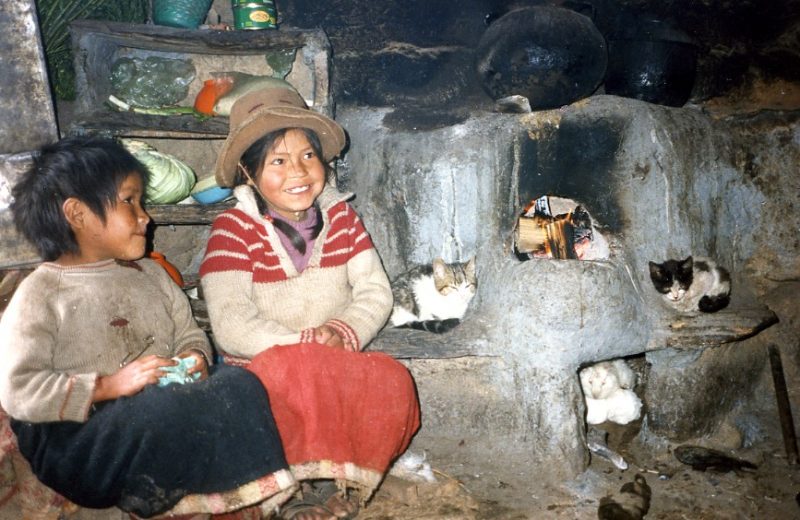
A young man added in a whisper that the shamans of Chillihuani are powerful, too powerful for him to dare venture to their village. Others confided that not much good comes from the people behind the towering mountains.
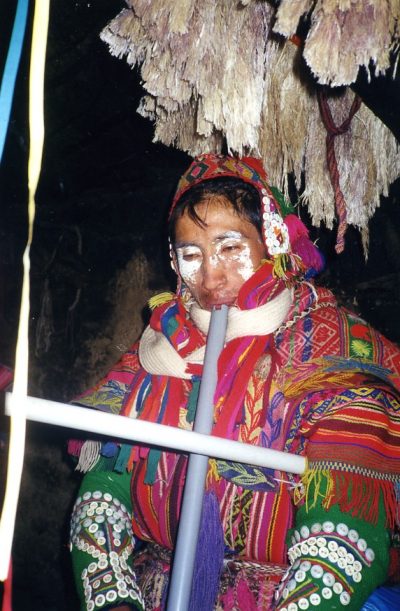
Since little is known about high-altitude pastoral societies which, given their remoteness, are the foremost custodians of Inca and pre-Inca customs and life ways, I was happy to follow the invitation of the healer Juan Mamani who struck me as a man of much integrity.
The eight-day celebration of Pukllay was filled with deep symbolic rituals, with music and songs about the past, about the greatness of the Inca empire and its tragic demise. The atmosphere was captivating, people’s movements, gestures and poetic interludes were of an elegance I had never seen before, as was the generosity of these people who lived at the very margins of existence.
Although I did not fully understand the meaning of every family or community ritual displayed, it became clear that each expressed a profound respect for humans, animals, plants and the spirit world. Throughout the days and nights of the celebration the central message of the rituals became clear. Only where there is respect can we find ways to live and act together. We must adjust and readjust to accommodate the various benevolent and malevolent forces within the cosmos. Pachamama, the earth mother, is the giver of life, but is also responsible for earthquakes and other natural disasters. Apus, the sacred mountains, protect the herds, but also send strong winds, lightning, hail and floods.
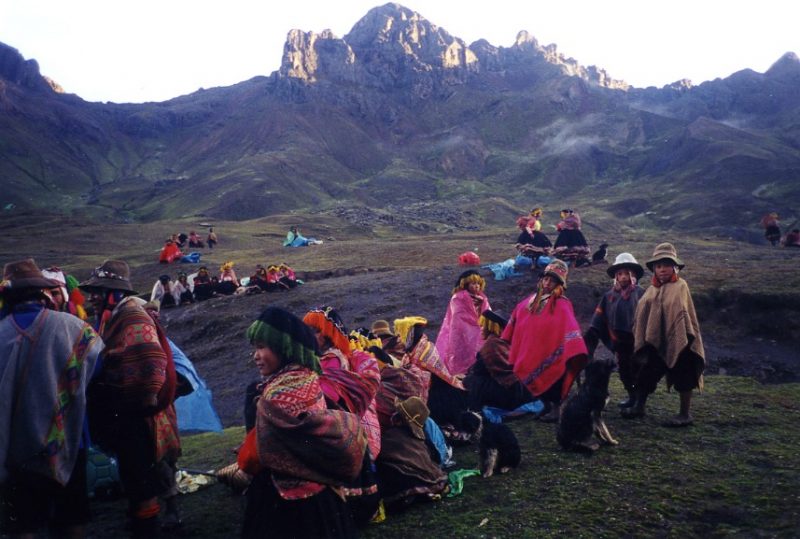
I noticed that the Andean people do not separate the natural from the spiritual world. They believe that, just like animals and people, all other parts of nature live, feel and breathe and therefore need food, drink, love and respect. The ancient rites reconfirm a close interdependence between all forms of life. Rituals are meant to reinforce the positive, to give hope to a life so harmonic and serene, yet so vulnerable in this mountain wilderness.

My first encounter with the herders of Chillihuani was only the beginning of a love for the Quechua people of the high Andes, their lifeways, their wisdom and their culture of respect. As our friendship deepened over the years and my understanding of their intricate culture grew, transcending the inconveniences which life at such high altitude can bring, I was ready to focus my studies on Andean culture on this village under the clouds. I had found a second home.

Throughout the years several people came with me to Chillihuani, among them three of my students. All of them were fond of this intriguing place and so was Prince Ludwig, the president of the German Red Cross which helped with sustainable village projects. Prince Ludwig and princess Marianne who left their castle in Germany for an earthen hut in Chillihuani, referred to their time in this village as the highlight of their trip to Peru.
Every year when I returned to Chillihuani I felt a stronger urge to write about this society where respect, as expressed in rituals and in everyday life, was the secret of survival in an unforgiving environment. At home I realized that with every word I wrote I was transported back to a place where I found wisdom, courage and pride within an atmosphere of love and respect. Writing for hours on end was no longer so confining.
Upon publication of Rituals of Respect – the Secret of Survival in the High Peruvian Andes (University of Texas Press, 1998), I was frequently asked how the Chillihuani herders instill respect in their children, so I embarked on writing a second book Growing up in a Culture of Respect – Child Rearing in Highland Peru (University of Texas Press, 2006).
At this point it is important to note, that as an anthropologist and author I owe every bit of success to the indigenous people. Without their cooperation, their patience, their willingness to take the risk of allowing an outsider into their community and the private spheres of their families, my books could not have been written, let alone published. After all, it is their insight and wisdom, their knowledge, their memory of the past transmitted throughout a long oral history that spark the narrative.
Their great sense of humor also helped where misunderstandings could otherwise have arisen or where I asked questions which are not considered ethical in a non-competitive society where no one wants to be declared a winner to the detriment of others.

Thus, in a horse race close to 5000 m.a.s.l., no winner was declared and by asking who won this spectacular race, I made a big mistake. But the herders forgave me as they did so many times.
From the very beginning of my visits in Chillihuani I was captivated not only by the rituals of respect, but also by the ways by which children are raised. Having raised two children myself I thought I had done a good job for the most part. But I was in for a surprise as I observed in greater depth how children grow up in this village under the clouds.
Children show respectful behaviour at an early age. When I asked the healer Juan Mamani and his wife Luisa what they consider most important in the upbringing of their children, they simultaneously responded: “We must always teach them respect”. They added that words are not necessary since parents and other adults must be role models for children to observe. I found it intriguing to see how parents socialize their children by combining their youngsters’ individual needs with the needs of their community which depends on capable and compassionate young people in the struggle to survive.

In comparing the upbringing of Chillihuani children with children in “developed” societies, our common beliefs are often turned upside-down. When one enters the small earthen huts, one could get the impression that the children of the highland herders have a deprived childhood. There are no specific children’s songs, dances or stories. From a young age, children participate in the adult world. It was interesting to see three year old Victor, dance to the rhythm of an adult love song. He remembered many of the lyrics which he sang with a serious look on his face. The onlookers laughed to tears while Victor enjoyed all the attention he received.

When I first arrived in Chillihuani, I was sad to see that children don’t have manufactured toys and I was determined to bring some to the village on my next trip. But I soon realized that the children themselves are capable of making toys, miniature homesteads and other complex structures out of mud, stones and other materials they can find outside in nature. Making their own toys certainly contributes to the creativity for which these children are known.
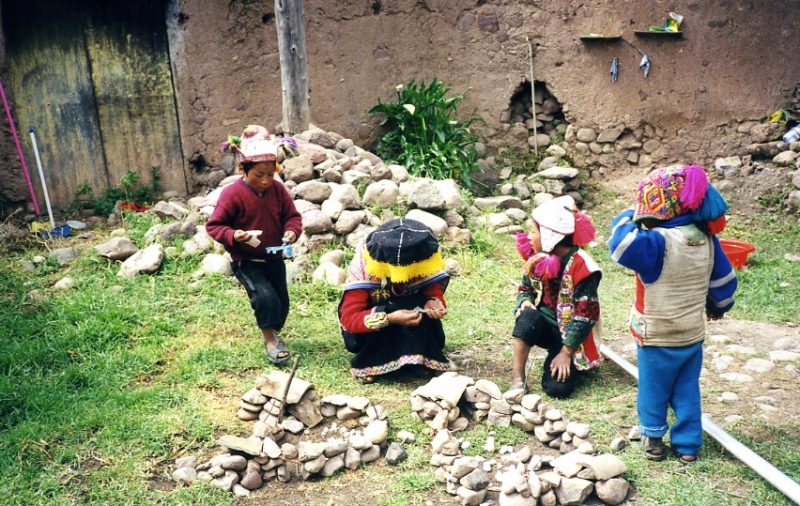
In school, children enjoy all subject areas but the favorite topic for both boys and girls is mathematics. This situation not only exists in Chillihuani but in all the high-altitude herding societies I visited. It took me some time before I found answers to this puzzle.
Despite the non-competitive attitude of herding societies, Chillihuani children have won many competitions when teachers took them to towns and cities in the valley. Math competitions are foremost among them. I was especially pleased when Anali, one of my godchildren who grew up in the very heights of Chillihuani was accepted by a university in Cusco to study Systems Analysis. Given her knowledge, her patience and respectful demeanor, I am happy that she can now explain to me the more complicated computing skills which have been difficult for me to grasp. The Andean people know very well that “reciprocity is the spice of life”. (See photo 8 when Anali was three years old. Now she is 29).
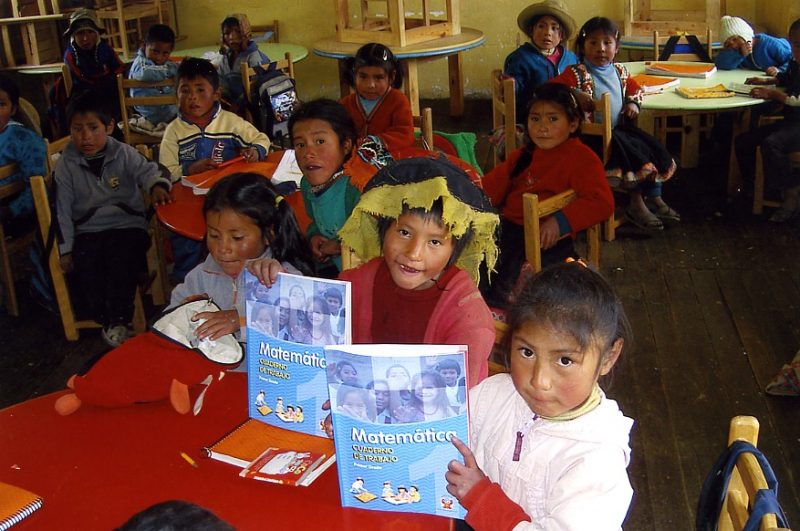
Yet, surprising achievements and adaptive strategies are not confined to childhood but continue into adolescence. Village elders and parents told me that adolescence was the best part of their lives and the young people agree that this is still so. Village elders confided that “our children approach adolescence and adulthood with confidence because they are prepared for life in every way.” For decades I have observed adolescents and young adults participate in every aspect and at every level of their society, culture and economy where they learn what is important to their family, their village and life beyond its confines. As they show love and compassion for others and prove themselves to be reliable and courageous, they receive the respect of family and community which, in turn, reinforces a feeling of pride about their achievements and self-assurance for being valued members of their society.
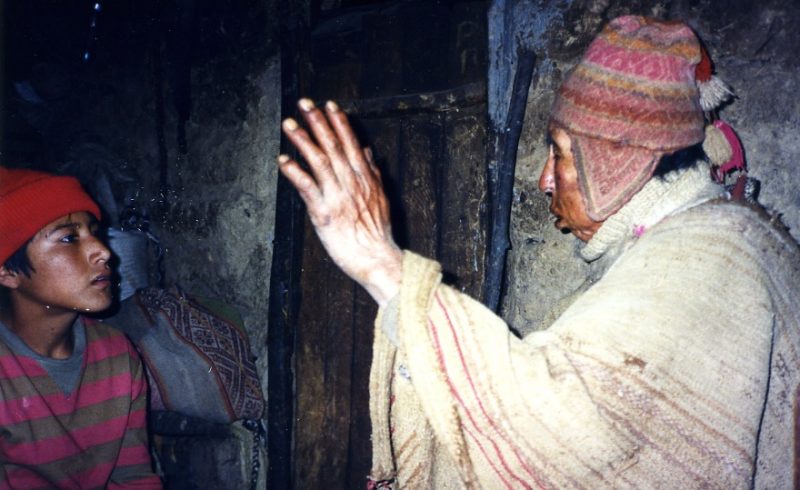
Over the past 29 years the people of the high Andes have provided me with a second home, revealed to me the past they know through oral history, discussed life and death in their village and offered their time to ascend with me to the high peaks and sacred mountain lakes. They gave me a new and unique perspective on life.

To reciprocate in some way for their kindness and generosity, I soon began to cooperate with their village on sustainable projects, such as solar light, solar hot water, a school, a health station, water projects, greenhouses, improved kitchen stoves, monthly health campaigns in the highest inhabitable regions, and others.
In 1992 we founded an NGO of volunteers, called “Yachaq Runa” (Wise People) in the city of Cusco, which deals with Andean Medicine, Nutrition and Ecology. I decided to put most of my time and efforts into practical endeavors in cooperation with this group of healers, pastoralists, peasant farmers, physicians, dentists, ecologists, and people from other occupations.
Soon we realized that the most serious problems we were dealing with were diseases, most of all the disfiguring and deadly tropical disease Leishmaniasis, which due to climate change and activities such as deforestation, oil and gas exploitation, had in some places reached epidemic proportions. This disease takes a vast toll mainly among young men who are forced to venture to jungle regions in search of work.
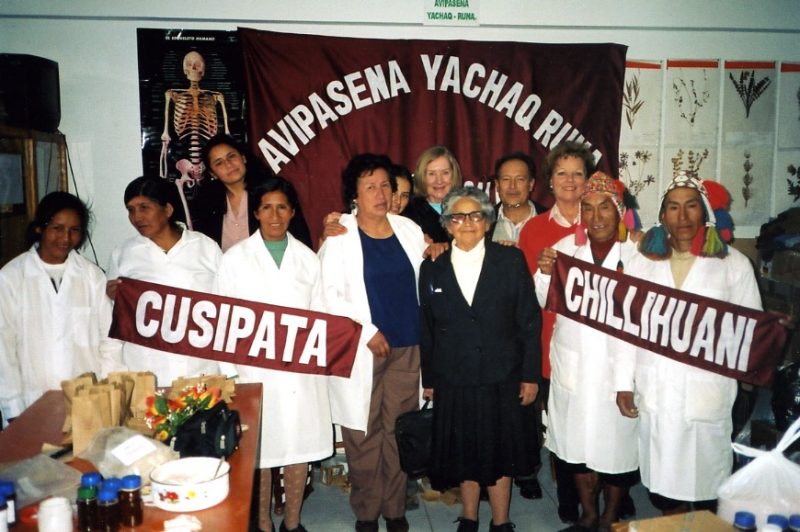
Although Doctors without Borders have recently cited Leishmaniasis as one of the most dangerous and neglected tropical diseases, little progress has been made to help the people affected, most of whom are poor and unable to pay for medicines, such as Glucantime, that has become very expensive, is difficult to obtain and can cause serious side effects.
Not even prominent organizations working on global health issues, such as the Bill and Melinda Gates Foundation, have thus far been able to assist Leishmaniasis patients. The stigma this disfiguring disease causes and the physical and psychological pain and economic hardship the affected and their families must endure, finally compelled me to write another book, this time a novel.
When Condors Call – a Novel of Peru (self-published by Chaska Publications, 2010, and available through Amazon.ca) is set in Peru during the Shining Path terrorist movement of the 1980s and 1990s when environmental, economic and political problems merged to make life even more challenging. The protagonists of the novel, a young physician and a student of botany, managed to survive major cultural shock waves as they worked to find an herbal remedy to cure Leishmaniasis. Caught between life and death, they become ever more deeply enmeshed in ancient Andean ideology where the call of the condor no longer means death, but the beginning of a spiritual bond that is stronger than life, giving way to healing, empowerment and creative energy.
The search for an effective and affordable medicinal plant that cures Leishmaniasis continues. In November 2016 with ten members of the Yachaq Runa group we left for the jungles of Madre de Dios in the hope to find the medicinal plant Ageratum conyzoides which in the past had cured people affected by Leishmaniasis. We did not find the plant, but will not give up hope.

The novel “When Condors Call” ends with concerns about Climate Change and its role in the rapid advance of tropical diseases. The fact that the climate in the Andes has been undergoing drastic changes was pointed out by indigenous elders as early as the mid-1980s when they witnessed the sacred mountains losing their white ponchos. They knew that such a process, which they had never seen before, could only lead to disaster. During the dry season when it seldom rains, glaciers are the only source of water on which to subsist. Glacial retreat is accompanied by extreme weather patterns, droughts and floods, which often wipe out harvests and destroy meadows, leaving people in mountainous regions, which are most vulnerable to climate change, with little on which to survive.
Every year I noticed that the glaciers receded further and became thinner. In 2009 when the news spread around the world that the Bolivian glacier Chacaltaya, located at an altitude of over 5000 m.a.s.l., had melted, causing the world’s highest ski resort to close, the situation was taken somewhat more seriously not only in the Andes but worldwide.
As extreme weather conditions caused a total loss of harvests in two consecutive years, the pastoralists and peasant farmers asked me to let the world know about their struggle for survival. At that point the efforts of students and staff at VIU and of family and friends, were most helpful as they assisted with several life-saving projects for my study communities. Nor could I resist any longer but had to take my notes since 1984 on climate change, with focus on the extremely serious water situation, and begin to write a book based on the plight of the indigenous Andean people, my conversations with scientists on that subject and available scientific reports. (Royalties for my books go to “Yachaq Runa” to implement projects and health campaigns).

The Tyndall Centre of Climate Change Research reports that Peru is the most water-stressed country in South America and the world’s third most vulnerable country to the impact of Climate Change. People depend on their glaciers for their very existence.
Yet melting glaciers, drought and unreliable precipitation are not the only problems causing water shortage. After 2005 increasingly more mining-, oil and gas companies invaded the Andes, poisoning land, air and the ever scarcer water in rivers, lakes and wetlands. The extraction of precious metals requires vast amounts of water.
In Peru alone, 50 percent of the Andean villages are under mining concession and 75% of the Peruvian rainforest is open to oil and gas exploration. Deforestation is also taking a severe toll. Without considering these issues, my manuscript on “Thirst in the Andes – Climate Change and Solutions for Survival” would not show the actual situation about the availability of water. Are people supposed to use water mixed with mercury, arsenic and other poisonous substances in their households, their corrals and on their fields and meadows?
Big corporate business from all over the world seems to be everywhere. Mineral, oil and gas exploitation takes place from high mountain glaciers down to the rain forest, where tribal societies, some of them hitherto never contacted, succumb to the poisonous water, disease and death the invaders bring. Although Peruvians understand to demonstrate against those who pollute their precious water, they are not always successful. The 23 Vancouver Island University students whom I took on a field school to Peru could not believe the struggle local people must engage in to keep the polluting invaders out.
Unfortunately there is no hope so far to eradicate Leishmaniasis since cutaneous and muco-cutaneous leishmaniasis is caused by protozoan parasites of the genus Leishmania, transmitted through the bite of sandflies of the genus Lutzomia. Apart from global warming, oil and gas exploitation and deforestation aid in the spread of this disease due to the increased need of people to work in jungle regions where this kind of sandfly is found. The sick people either die in the jungle or return to their mountain villages. Some villages are more affected than others.
During health campaigns, which we conduct in many villages, including Chillihuani (with its Culture of Respect), the Yachaq group treats people with a variety of diseases, including Leishmaniasis. Sometimes patients must be sent to a hospital in Cusco, but there, too, modern medicine, such as Glucantime is scarce and very expensive. For this reason we – mainly the Yachaq group – with the help of botanists have been on the lookout for medicinal plants – mainly Ageratum conyzoides which in the past has been known to cure Leishmaniasis.
This is the time when an author is driven to write, spending weeks, months or years tied to the computer and confined in an office. But are there presses which dare to publish what big corporate business does not want to hear?

On a more positive note, an attempt to start mining activities under the glaciers of the sanctuary of Qoyllur Rit’i above 5000 m.a.s.l. was successfully opposed by people throughout Peru. Tens of thousands of pilgrims flock to the Sinakara mountain range every year to perform ancient Andean rituals in honor of the glaciers of Qoyllur Rit’i, mixed with Christian symbols. Large-scale demonstrations have also been successful in a few other parts of the Andes. But the glaciers keep melting and people keep wondering whether they can drink the last drops of water still running from their sacred mountains.
*
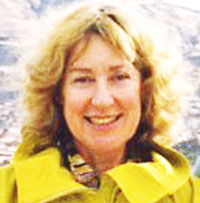
Based on her first-hand experiences in the Andes as an anthropology professor at Malaspina University College, Inge Bolin’s other books, mentioned in the article, are Rituals of Respect: The Secrets of Survival in the High Peruvian Andes (University of Texas Press, 1998) and Growing up in a Culture of Respect – Child Rearing in Highland Peru (University of Texas Press, 2006) for which she received the “Circle of Courage Award” for her contribution to the science and practice of positive youth development in 2009. The latter book is being translated into Spanish to be published by Editorial Horizonte in Lima, Peru. Born in Germany, Inge Bolin has also studied and worked in Germany, Scotland, Switzerland, France, Spain, Belize, Guatemala, Singapore, Indonesia, Peru, and the US. She holds certificates and degrees through to the PHD and speaks German, English, Spanish, French, some Mandarin Chinese and some Quechua and writes in the first four languages.
*
The Ormsby Review. More Readers. More Reviews. More Often.
Reviews Editor: Richard Mackie
Reviews Publisher: Alan Twigg
The Ormsby Review is hosted by Simon Fraser University.
—
BC BookWorld
ABCBookWorld
BCBookLook
BC BookAwards
The Literary Map of B.C.
The Ormsby Review